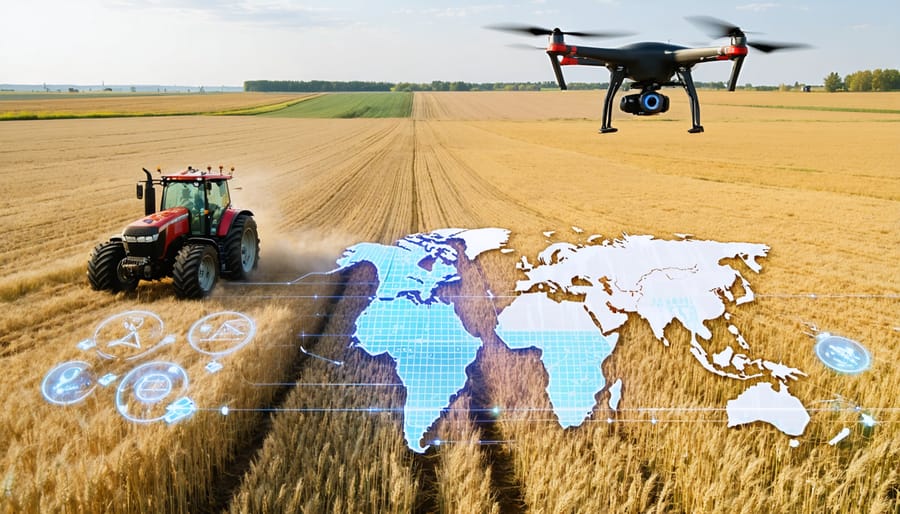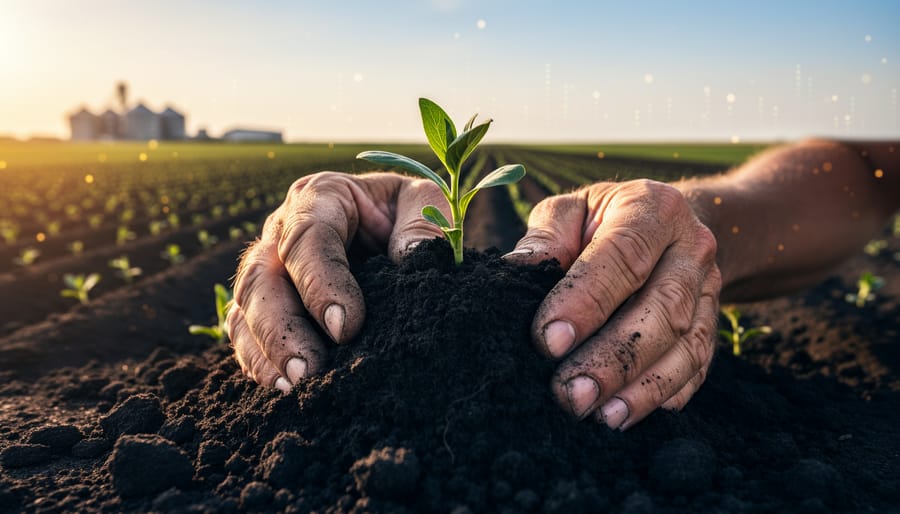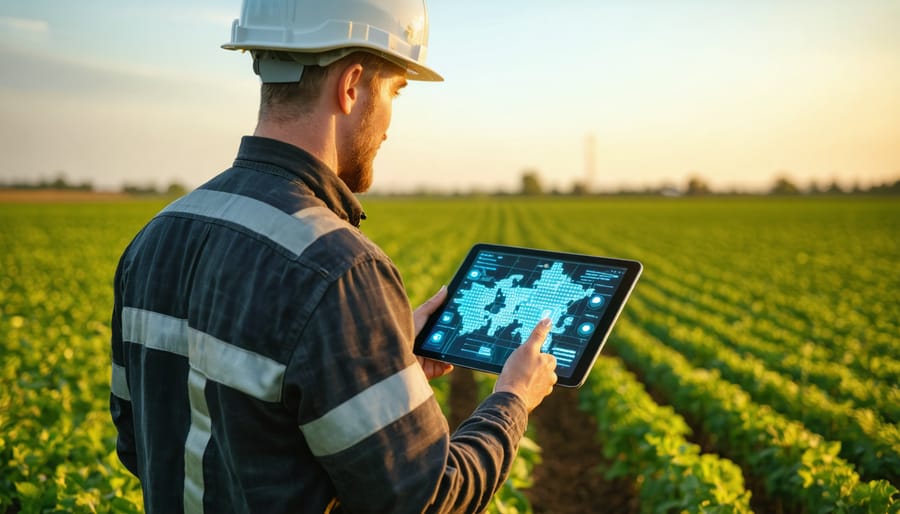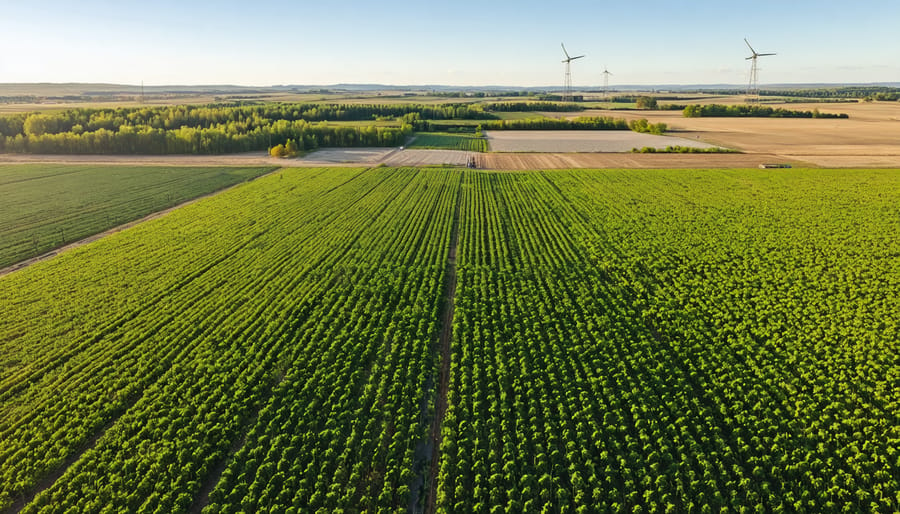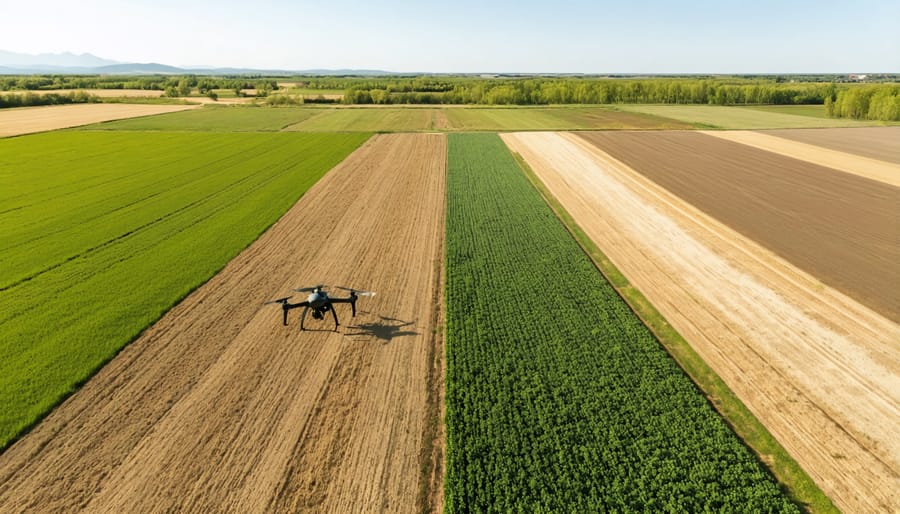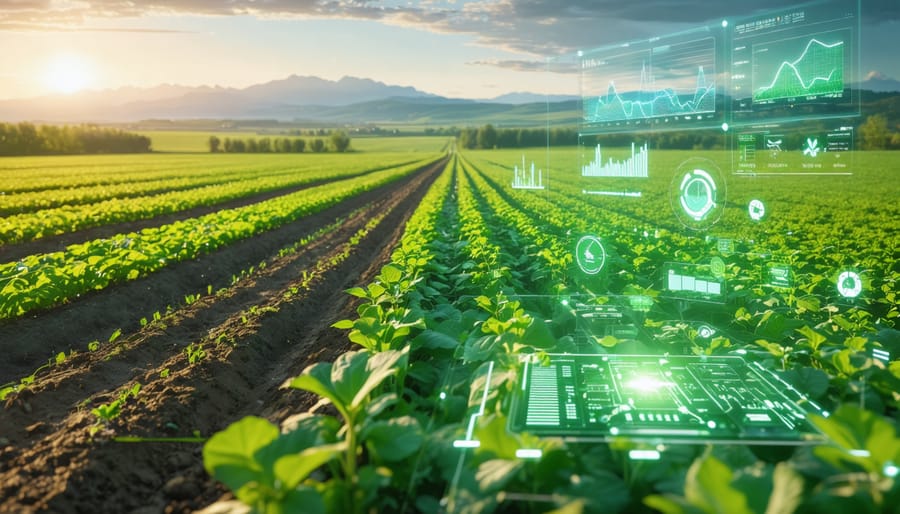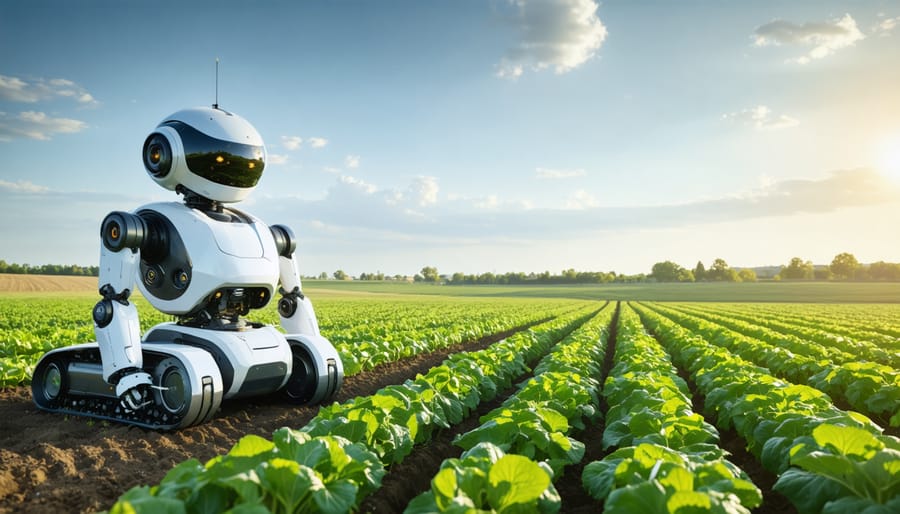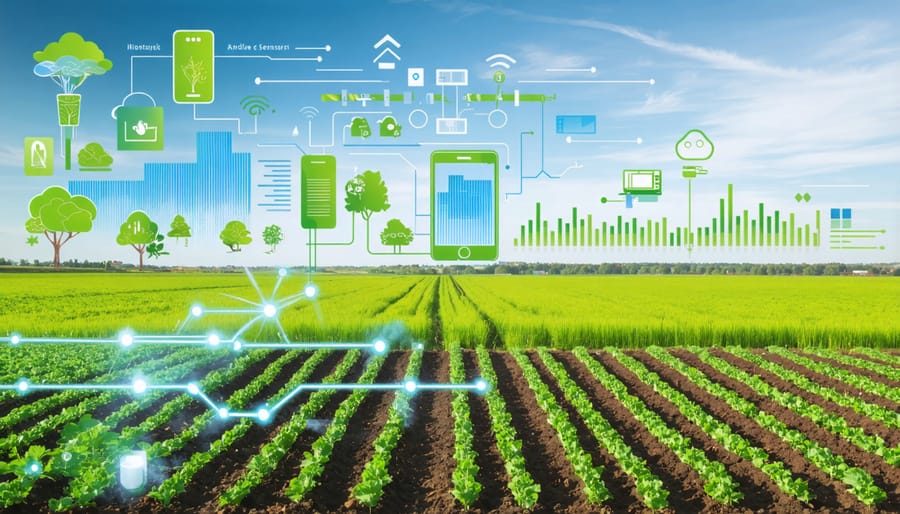Technology is revolutionizing Canadian agriculture, transforming traditional farming practices into precise, data-driven operations that boost yields while preserving our soil’s legacy. From Alberta’s wheat fields to Ontario’s vineyards, smart sensors now monitor soil moisture levels within 1% accuracy, while autonomous tractors guide themselves through fields using centimeter-precise GPS mapping. These innovations aren’t just changing how we farm – they’re ensuring our agricultural future remains sustainable and productive.
Local farmers like Mike Robertson in Red Deer have increased their crop yields by 30% after implementing AI-powered irrigation systems that deliver water exactly when and where crops need it. Meanwhile, drone technology enables Alberta producers to spot crop stress two weeks earlier than traditional field walks, preventing potential losses of up to $100 per hectare.
Yet this technological revolution goes beyond machinery. Soil microbiome mapping, predictive weather analytics, and blockchain-based supply chain tracking are empowering farmers to make decisions based on real-time data rather than historical patterns. For Canadian agriculture, these advancements represent more than progress – they’re essential tools for adapting to changing climate patterns while maintaining our position as global leaders in sustainable food production.
Precision Agriculture Tools Transforming Organic Operations
GPS-Guided Systems for Optimal Resource Management
GPS-guided systems have revolutionized how Alberta farmers manage their resources, offering unprecedented precision in every aspect of farm operations. These systems, now standard on many modern tractors and implements, use satellite technology to guide equipment with accuracy down to 2.5 centimetres.
For Calgary-area farmer Sarah Thompson, implementing GPS guidance has reduced her input costs by 15% through precise seed placement and fertilizer application. “We’re not just saving money,” she explains, “we’re protecting our soil by minimizing overlap and preventing over-application of inputs.”
The technology enables variable-rate application, where different areas of a field receive precisely what they need. Soil mapping combined with GPS guidance allows farmers to apply specific amounts of fertilizer, water, and other inputs based on soil conditions and crop requirements in each zone.
During harvest, GPS systems track yields across fields, creating detailed maps that inform next season’s planning. This data-driven approach has helped Lethbridge County producers increase yields by an average of 7% while reducing water usage by 20%.
Getting started with GPS guidance doesn’t have to break the bank. Many equipment dealers offer retrofit options for existing machinery, and provincial programs often provide support for technology adoption. Local farming co-ops also organize workshops where experienced users share their knowledge with neighbours interested in implementing these systems.
Drone Technology for Crop Monitoring
In recent years, Alberta farmers have increasingly turned to drone technology as a game-changer for monitoring crop health and implementing organic pest management strategies. These aerial assistants provide precise, real-time data that helps farmers make informed decisions while maintaining organic certification requirements.
Local farmer Sarah Thompson from Lethbridge reports saving nearly 30% on pest control costs after incorporating drones into her operation. “The infrared sensors detect pest infestations before they become visible to the naked eye,” she explains. “This early warning system allows us to target problem areas with approved organic treatments before damage spreads.”
Modern agricultural drones equipped with multispectral cameras can scan up to 160 hectares per hour, creating detailed maps of crop health, soil moisture levels, and pest activity. The technology identifies stress patterns in crops through colour variations, helping farmers spot potential issues weeks before they become apparent from ground level.
For organic operations, drones offer particular value in monitoring beneficial insect populations and tracking the effectiveness of natural pest deterrents. The detailed imagery helps farmers adjust their integrated pest management approaches while staying true to organic principles. Many Alberta farming cooperatives now share drone resources, making this technology accessible to smaller operations through cost-sharing programs.
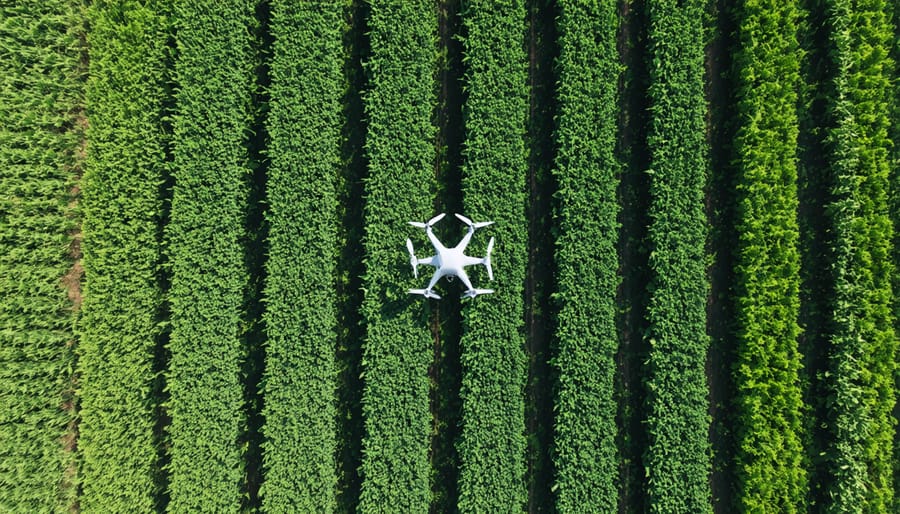
Smart Soil Management Systems
Soil Sensors and Real-Time Analysis
In recent years, Alberta farmers have embraced smart soil monitoring techniques that transform how we understand and manage our soil health. These innovative IoT sensors provide real-time data on crucial factors like moisture levels, nutrient content, and pH balance, helping farmers make informed decisions about irrigation and fertilization.
Local farmer Sarah Thompson from Lethbridge reports a 30% reduction in water usage since implementing soil moisture sensors across her 400-hectare organic farm. “The sensors alert me through my smartphone when specific areas need attention, rather than relying on traditional scheduling or gut feel,” she explains.
Modern soil sensors can be installed at various depths, typically between 15 and 60 centimetres, creating a comprehensive soil profile. The data collected feeds into user-friendly dashboards, allowing farmers to track trends over time and adjust their practices accordingly. Many Alberta farmers have found particular value in monitoring spring thaw patterns and frost depths, crucial information for our climate.
These systems are becoming more affordable and easier to maintain, with many featuring solar-powered units and wireless connectivity. The initial investment, averaging $2,000-3,000 for a basic system, often pays for itself within two growing seasons through improved resource management and increased yields. Local agricultural extension offices offer support programs to help farmers implement these technologies effectively.
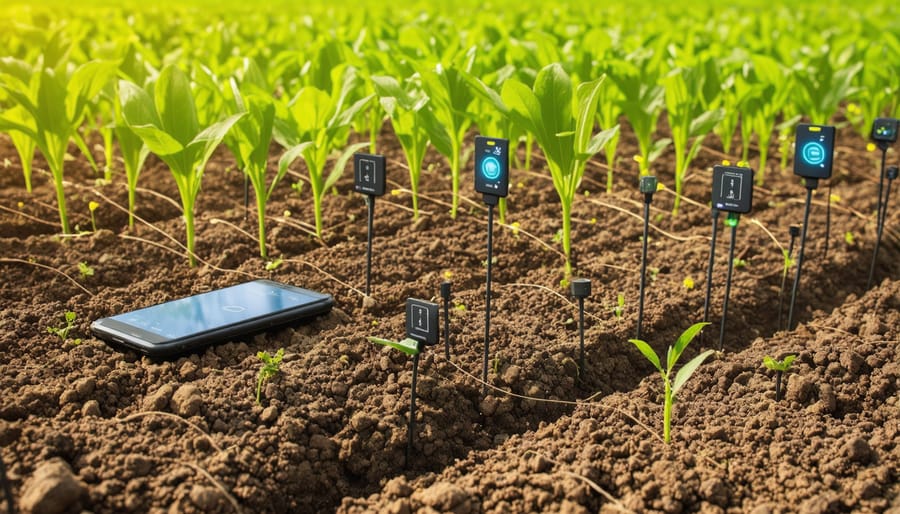
Automated Composting Systems
Modern composting has evolved far beyond traditional pile turning, with automated systems now leading the way in efficient organic matter management. Here in Alberta, farmers are increasingly adopting smart composting solutions that combine sensors, automated turning mechanisms, and climate control systems to optimize the decomposition process.
These systems typically feature moisture monitors and temperature probes that continuously track conditions within the compost. When readings fall outside optimal ranges, automated sprinklers adjust moisture levels while mechanical turners activate to maintain proper aeration. This precision control helps achieve consistent, high-quality compost in about half the time of traditional methods.
Local farmer Sarah Henderson from Red Deer County implemented an automated composting system last year, reducing her labour costs by 60% while doubling her compost output. “The system alerts me through my phone if anything needs attention, but mostly it runs itself,” she notes.
For smaller operations, modular automated systems are available starting at around $15,000. These units can process up to 500 kg of organic matter weekly and are particularly popular among market gardeners. Larger commercial systems, capable of handling several tonnes daily, typically range from $50,000 to $200,000.
The latest systems also incorporate artificial intelligence to predict optimal turning schedules and adjust parameters based on weather forecasts, ensuring year-round efficiency even during our harsh Alberta winters.
Alberta Success Stories: Tech-Driven Organic Farms
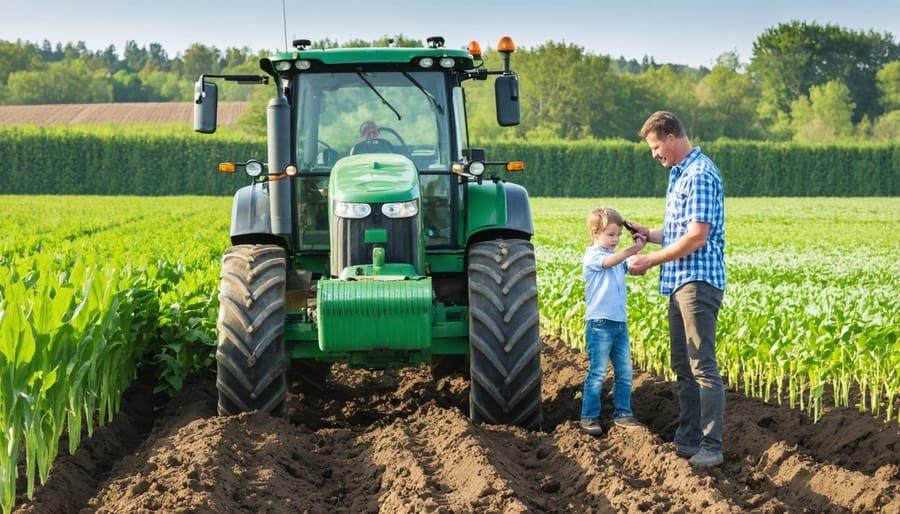
The Thompson Family Farm’s Digital Transformation
Located just outside of Olds, Alberta, the Thompson Family Farm has been operating for three generations, specializing in organic grain production across 800 hectares. In 2019, Sarah Thompson and her parents decided to embrace digital transformation while maintaining their commitment to organic farming principles.
The Thompsons started by implementing precision agriculture tools, beginning with GPS-guided tractors and soil sensors. “We were initially skeptical about bringing too much technology into our organic operation,” Sarah explains. “But we quickly realized these tools could help us be better stewards of the land while improving our efficiency.”
Their most significant investment was a drone-based field monitoring system, which helps them identify weed pressures and nutrient deficiencies early. This technology has reduced their manual field scouting time by 60% and allows for more targeted organic pest management strategies.
The farm also adopted a comprehensive farm management software system to track everything from seed varieties to soil health data. This digital record-keeping has proved invaluable for organic certification compliance and has streamlined their documentation process, saving approximately 15 hours per week during peak season.
Weather stations installed across their property now provide micro-climate data, helping the Thompsons make more informed decisions about planting and harvesting. This technology has been particularly valuable in Alberta’s unpredictable climate, helping them reduce crop losses by an estimated 20% during extreme weather events.
“The key was implementing these changes gradually,” Sarah notes. “We started with one field, tested the technology, and expanded based on what worked for our specific needs.” The family invested approximately $75,000 in their digital transformation over two years, but they’ve seen a return on investment through increased yields and reduced labour costs.
Their success has inspired other organic farmers in the region to explore similar technologies. The Thompsons now regularly host farm tours, sharing their experiences and helping build a community of tech-savvy organic producers in central Alberta.
Prairie Organic Cooperative’s Tech Initiative
In the heart of Alberta’s farming community, the Prairie Organic Cooperative has launched a groundbreaking initiative that’s transforming how small-scale farmers access and implement agricultural technology. Founded in 2021 by a group of 15 organic farmers, the cooperative now serves over 100 members across the province, demonstrating the power of community-based approaches to technological advancement.
The cooperative’s innovative shared-resource model allows members to access cutting-edge equipment and software that might otherwise be cost-prohibitive for individual farms. This includes precision agriculture tools, drone technology for crop monitoring, and advanced soil testing equipment. Members can book equipment through a user-friendly online platform, paying only for their actual usage time.
“We’ve seen a 30% increase in efficiency since joining the cooperative,” shares Sarah Thompson, who operates a 160-hectare organic grain farm near Red Deer. “The shared drone service has revolutionized how we monitor crop health, and we’re now catching issues weeks earlier than before.”
Beyond equipment sharing, the cooperative runs a mentorship program where tech-savvy members help others navigate new tools and systems. Monthly workshops cover topics from GPS-guided tractors to mobile apps for pest management, ensuring that no farmer is left behind in the digital transformation.
The initiative has also developed partnerships with local agricultural colleges, creating apprenticeship opportunities for young farmers interested in organic agriculture and technology. This connection helps bridge the generation gap while ensuring traditional farming wisdom isn’t lost in the rush to modernize.
Cost-sharing results have been impressive, with members reporting average savings of $15,000 annually on technology-related expenses. The cooperative’s success has sparked interest from other regions, with similar programs now emerging in Saskatchewan and Manitoba.
What sets this initiative apart is its emphasis on maintaining organic principles while embracing technology. All implemented solutions must align with organic certification requirements and support sustainable farming practices, proving that innovation and tradition can work hand in hand.
Getting Started with Ag-Tech on Your Organic Farm
Getting started with ag-tech doesn’t have to be overwhelming or expensive. Begin by assessing your farm’s specific needs and identifying areas where technology could provide the most significant impact. Many Alberta farmers find that implementing digital farm management tools is an excellent first step, with costs ranging from $500 to $2,000 annually.
Start small by exploring free or low-cost options. Weather monitoring stations, which typically cost between $300-800, can help optimize irrigation and pest management decisions. Mobile apps for soil testing and crop monitoring often offer free basic versions, perfect for testing the waters before investing in premium features.
Connect with your local organic farming association to learn about available grants and funding opportunities. The Canadian Agricultural Partnership (CAP) program offers cost-sharing initiatives for technology adoption, covering up to 50% of eligible expenses. Many equipment suppliers also offer lease-to-own options, making newer technologies more accessible.
Consider joining a farmer-led technology group or participating in demonstration days. The Organic Alberta Network regularly hosts workshops where experienced farmers share their successes and lessons learned with various ag-tech solutions. These events provide valuable hands-on experience and networking opportunities.
Resources available through provincial agricultural extension services can help you evaluate different technologies. The Alberta Farm Management Network offers free consultations to assess which solutions might work best for your operation. They can also connect you with early adopters who can share their experiences.
Remember to factor in training time and potential learning curves. Many suppliers offer implementation support and training programs. Consider scheduling technology upgrades during your off-season to minimize disruption to farm operations. Start with one system at a time, master it, and then gradually expand your tech toolkit as your comfort and needs grow.
The integration of technology in organic farming represents a significant step forward for Canadian agriculture, offering a perfect balance between traditional organic principles and modern efficiency. As we’ve seen through successful implementations across Alberta, these innovations have led to increased yields, reduced labor costs, and improved soil health monitoring. The future outlook is particularly promising, with emerging technologies like AI-powered pest detection and precision irrigation systems becoming more accessible to organic farmers. By embracing these advancements while maintaining organic certification requirements, our farming communities are well-positioned to meet growing consumer demand for sustainable produce. The key to success lies in thoughtful adoption, community knowledge-sharing, and continuous learning about new technological solutions that align with organic farming principles. As we move forward, the combination of traditional organic wisdom and modern technology will continue to strengthen Canadian organic agriculture’s resilience and productivity.

